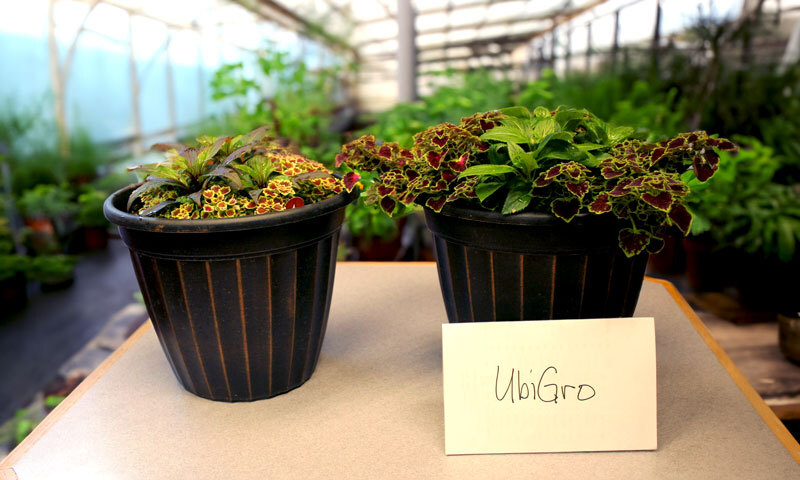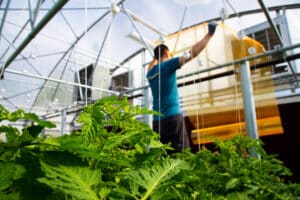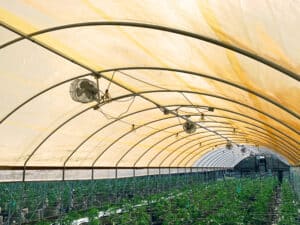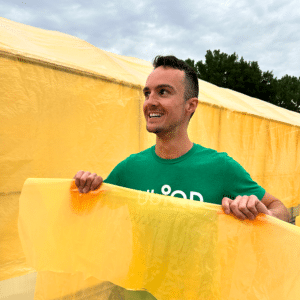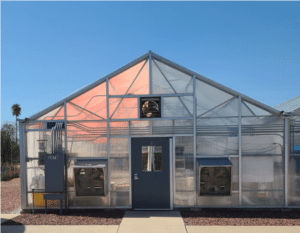
The Power of Red Light in Greenhouse Farming
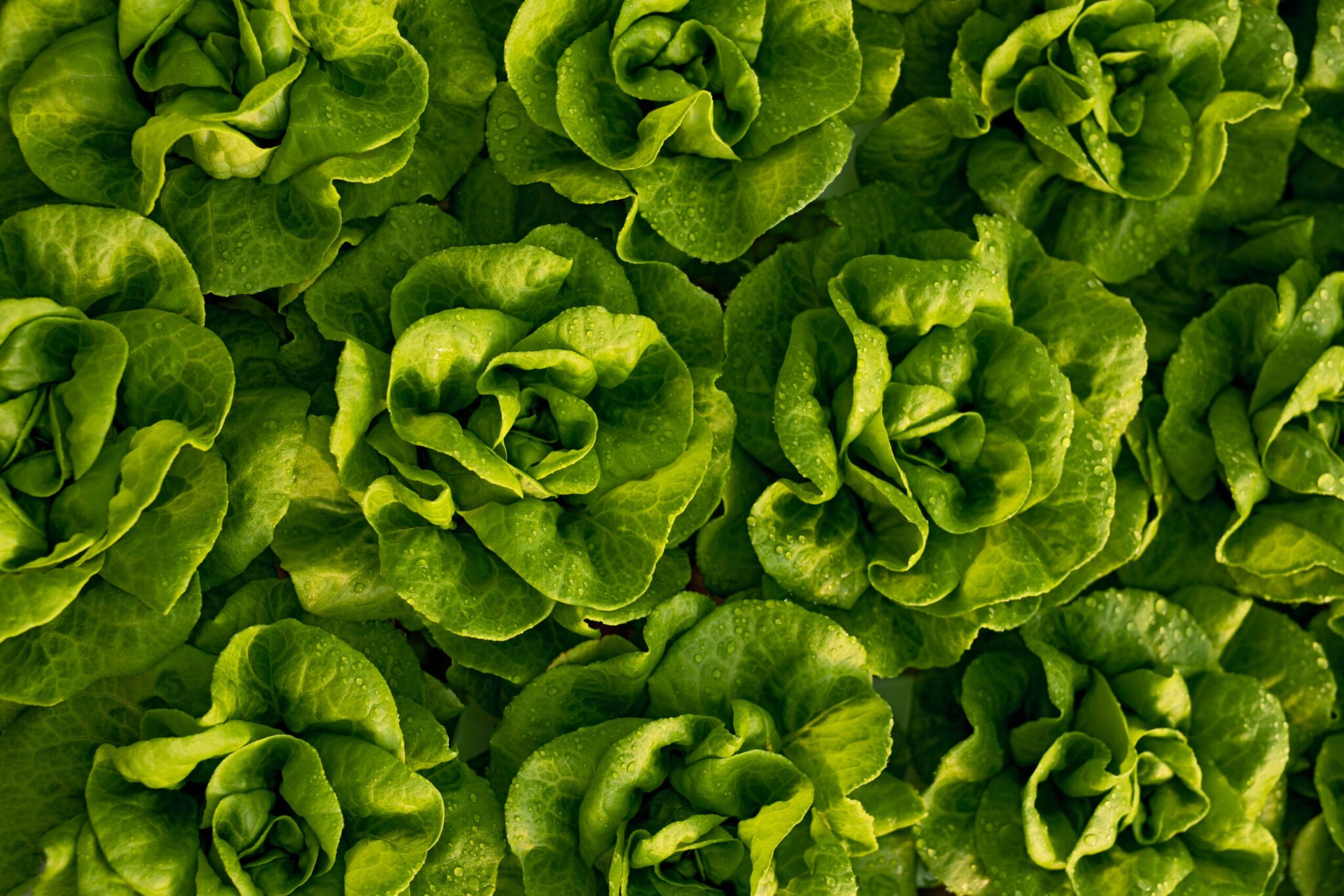
The use of supplemental lighting in greenhouse farming has become increasingly popular to increase plant growth and yield and has helped further develop our understanding of how the spectrum of light provided to plants affects plant growth and development. In particular, the use of red light, defined as light with wavelengths 600 – 700 nm, has been shown to have numerous benefits for plant development and production.
The incorporation of red light in greenhouse farming goes beyond a simple lighting strategy; it represents a nuanced approach to optimizing plant growth and development. By harnessing the benefits of red light, farmers can unlock the full potential of their crops, leading to more sustainable and efficient agricultural practices.
This blog will focus on three key topics regarding the use of red light in greenhouse farming: 1) how red light improves photosynthetic efficiency, 2) increased light absorption for red photons, and 3) how red light and far-red light interact with phytochrome absorption to control plant morphology, including flowering and fruiting.
How Red Light Improves Photosynthetic Efficiency
Photosynthesis is the process by which plants convert light energy into chemical energy to fuel growth and development. The efficiency of photosynthesis is determined by the amount of light that is absorbed by the plant’s pigments, particularly chlorophyll. The McCree curve (McCree 1976) is a graphical representation of the relationship between photosynthetic rate and light wavelength. It shows that red light is more efficient for photosynthesis than blue light, with the peak efficiency occurring at around 625 nm (Figure 1). Interestingly, green light (500 – 600 nm) is also more efficient than blue light. Coupling its higher photosynthetic efficiency with deeper penetration into the plant canopy, reaching unsaturated leaves lower on the plant, green light plays an active role in biomass production. Check out our blog covering green light for more information.
Red light in greenhouse farming enhances photosynthetic efficiency, particularly in the crucial wavelength range of around 625 nm. This optimized use of red light contributes to increased biomass production in greenhouse crops. Explore our blog for comprehensive insights into the significance of Red Light in Greenhouse Farming for sustainable and efficient cultivation practices.
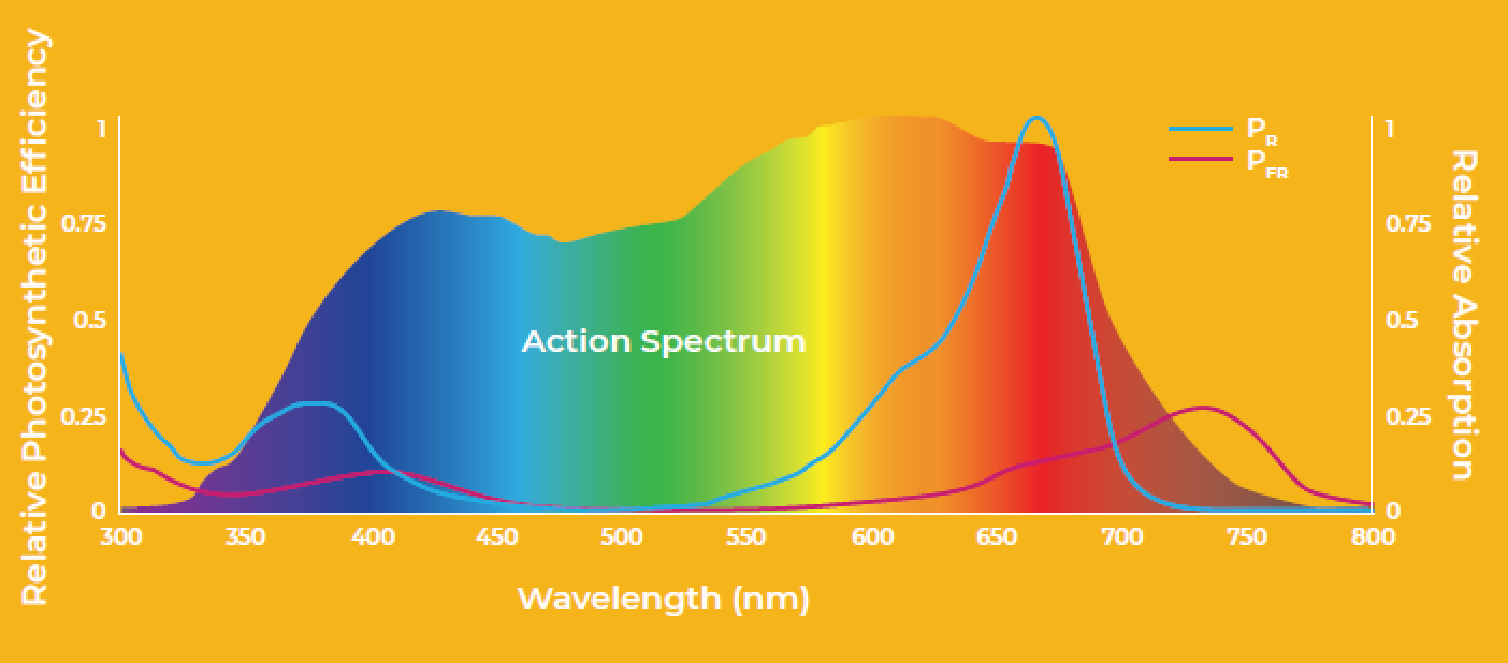
Figure 1. The action spectrum developed by McCree showing the relationship between photosynthetic rate and light wavelength. Red and blue curves represent absorption of phytochromes.
The primary reason why red light is more efficient than other colors is that chlorophyll, the primary pigment involved in photosynthesis, has a higher absorption coefficient for red light, meaning that chlorophyll molecules are more effective at capturing and utilizing red light energy to drive photosynthesis compared to other colors. Additionally, red light is less absorbed by other pigments, such as anthocyanin, a pigment that gives plants their red and purple coloration. This means that more red light can penetrate deeper into the plant’s tissues, allowing for greater absorption by chlorophyll.
More recent academic research in photobiology has also shown the importance of red light to plant development, especially crop production. In a study of how spectra affected plant development for a diverse set of crops, eight different light recipes with different blue-to-red light ratios were used to grow seven different plants (tomato, cucumber, radish, pepper, soybean, lettuce, and wheat) in growth chambers and the plant development was characterized (Snowden et al. 2016). While the study focused its discussion on how changing the blue light fraction in the spectra affected plant growth, the fraction of red light was modified in an opposite trend compared to the blue light fraction. When the blue light fraction was low, the fraction of red-light present was high and vice versa, when blue was high, the red-light fraction was lower. The results from the study showed that for all crops, the dry mass gain was highest when the blue light fraction was low, between 11-15%, and the corresponding red-light fraction was over half of the entire spectrum. Therefore, a balance of all colors is needed for optimal plant development, but optimizing for a high fraction of red light and lower fraction of blue light has been shown to improve crop production.
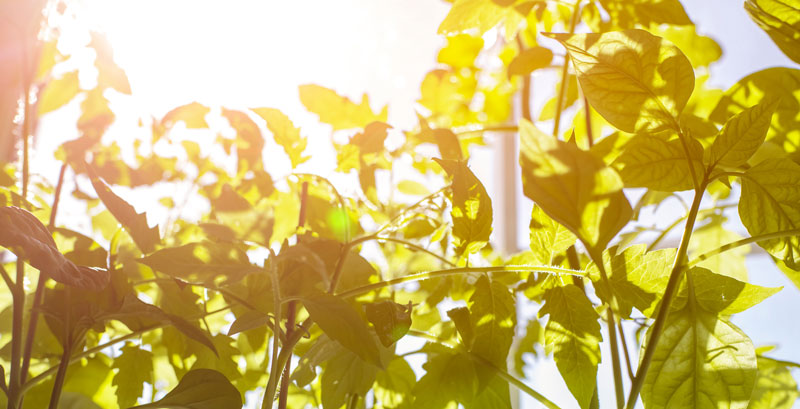
Increased Light Absorption for Red Photons
In addition to its effects on photosynthetic efficiency, red light is also strongly absorbed by chlorophyll, with absorption peaks of 625 nm for chlorophyll B and a peak at 650 nm for chlorophyll A. Where red light is absorbed also makes a difference. Since red light is absorbed strongly by chlorophyll, under direct illumination, red photons are primarily absorbed by the highest leaves in the canopy and thus risk being exposed to excessive light intensity. The photosynthetic efficiency decreases with increasing intensity as the saturated leaves of the plant dissipate excess energy as heat, which is a plant response to avoid oxidative damages under high light (Ruban 2015). Thus, it is important that a light spectrum with a higher red-light fraction is accompanied with light diffusion to better spread the light across the entire plant canopy. To learn more about the importance of light diffusion check, out this blog.
Coupled with lower blue light fractions, red light has specifically been shown to increase leaf area in plants, which can result in an increase in crop yield (Neo et al. 2022). In one study, Cope and Bugbee demonstrated spectra with lower blue-to-red ratios given to plants grown under LEDs resulted in leaf expansion and stem elongation (Cope and Bugbee, 2013). This expansion can lead to an increase in total leaf area, allowing for more surface area for light absorption, suggesting that a higher fraction of red light can have a positive impact on plant growth by increasing light absorption through cell expansion and increased leaf area, thus improving radiation capture.
Red to Far-red Ratio Affects Plant Morphology, Flowering, Fruiting
Phytochromes are a family of photoreceptors that are involved in the perception of light quality and quantity in plants. They are responsible for sensing changes in the local light environment and the time of year, and can also play a role in shade avoidance in plants.
Phytochromes are proteins and exist in two interconvertible forms: Pr and Pfr. Pr is the inactive form and absorbs red light which then converts it to Pfr, the active form, while Pfr absorbs far-red light and is converted to Pr. As the plant absorbs light, the ratio of red to far-red light stabilizes into an equilibrium and can inform the plant about its surrounding environment. For example, because more blue and red light is absorbed by the upper canopy of taller plants, smaller plants that are being shaded by neighboring plants will receive relatively more far-red light, as it is not strongly absorbed by leaves. This creates a low red to far-red ratio, which can trigger shade avoidance responses such as stem and leaf extension (Cerny et al. 2003, Finlayson et al. 2010, Skinner and Simmons 1993), in order to compete for the available light.
Lower red to far-red ratios also have been shown to promote flowering, while higher ratios tend to inhibit flowering. For example, in a study by Cerny in 2003, petunias flowered up to 12 days sooner depending on photoperiod. Red to far-red ratios can be controlled by either adjusting the red or far-red portion of the spectrum, depending on what ratio is required. In tomatoes as well, lower red to far-red ratios have been shown to promote flowering and fruiting (Kalaitzoglou et al. 2019).
Conclusion
In conclusion, red light has numerous benefits for plant growth and production in greenhouse farming. It improves photosynthetic efficiency, increases light absorption, plays an important role in fruiting and flowering, and interacts with phytochromes to affect plant morphology. The McCree curve indicates that red light is the most efficient waveband for photosynthesis, and studies have shown that red light is more efficient than blue light in terms of photosynthesis. Finally, phytochromes interact with red light and far-red light to affect plant morphology, playing a role in shade avoidance and sensing changes in the local light environment and time of year. Given these benefits, red light is arguably the most important waveband of light for efficient crop production. Optimizing the sunlight spectrum to include more red light can greatly benefit greenhouse production by improving plant growth and productivity.

Dr. Matt Bergren is the Chief Product Officer at UbiQD, Inc. and has a background in nanomaterials and sunlight harvesting for agriculture and energy. He helped develop and launch the UbiGro brand of agriculture products at UbiQD and is passionate about utilizing sustainable resources and practices to help feed and power the world. Dr. Bergren can be reached at [email protected]
Share:
Connect With Us
Company
Resources
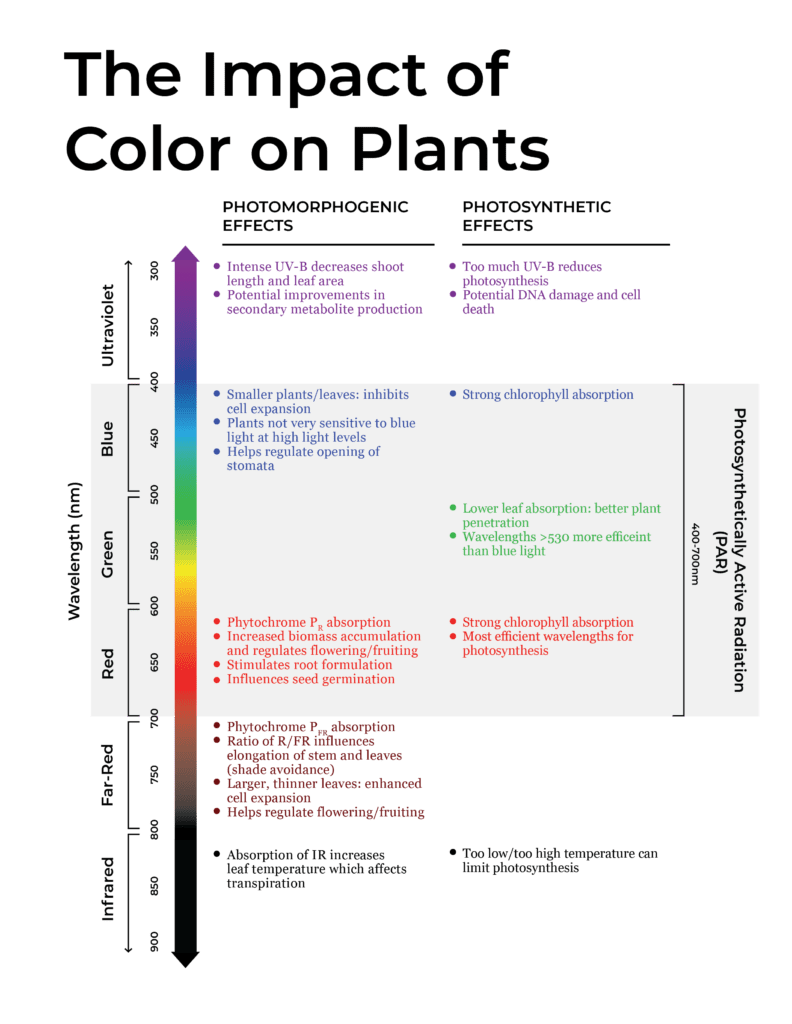

Hunter McDaniel, PhD
Founder & CEO
Hunter earned a Ph.D. in Materials Science and Engineering at the University of Illinois at Urbana-Champaign, before joining Los Alamos National Laboratory in the Chemistry Division. Ultimately the value proposition of UbiGro is about boosting crop yields and quality without the cost or energy impact of lighting. Hunter has more than fifty publications and patents, and more than 2000 total citations, h-index: 20. Hunter fundamentally believes that novel materials underpin every significant technology advancement, and he is focused on leveraging new materials to have a lasting and sustainable impact.

Damon Hebert, PhD
Director of Agriculture
Damon brings a wide range of experience in agriculture, materials science, spectroscopy, and small business. During his time in Prof. Angus Rockett’s research group at The University of Illinois at Urbana-Champaign (UIUC), Hebert authored a doctoral thesis and multiple papers on the materials science of CIGS semiconductor materials, which is closely related to the materials developed at UbiQD. He also served as a consultant to Nanosolar, a CIGS nanocrystal solar cell manufacturing company. Hebert has industry experience having co-founded Dr. Jolly’s, a leading cultivation and distribution operation in Bend, OR.

Tania Lafaille
Sales Representative
Tania is a UbiGro Sales Representative, with over 7 years of experience in product sales (specifically berries and avocados) covering all of North America and parts of South America. While in agriculture, Tania has cultivated strong relationships with growers and distributors, granting her a unique insight into both perspectives. That understanding, paired with her fierce dedication to results, drives her fun and fiery commitment to her craft. Tania is based in Gilroy, CA.

Tyler Veyna
Sales Representative
Tyler brings 15 years of experience in Greenhouse production and facility management of a wide range of crops in multiple states to the UbiGro team. Based in Salinas, California. “Being a fourth-generation farmer, I look to improve and empower the grower, and with UbiGro, we can do just that.”

Jim Gideon
Sales Manager
Jim Gideon is an UbiGro Sales Manager, with over 25 years of greenhouse industry sales experience covering all of North America. Previously Jim has worked for Green Tek, Plazit-Polygal, Texel, Cherry Creek, and Nexus. He is based in Montgomery, AL, and Jim believes that “light is everything to the grower.”

Eric Moody
Director of Sales
Eric Moody is UbiQD’s Director of UbiGro Sales. Eric has more than 6 years of experience in horticulture lighting industry, building relationships with greenhouse growers of all sizes and crops on optimal lighting for their growing operation, and most recently managed a North American sales team for PL Light Systems. Overall, Eric has been in sales leadership positions for more than 13 years. Eric brings with him a great understanding of the market and available technologies for growers, greenhouse facilities, and sales leadership. Reach Eric by phone at 541-490-6421 or by email at [email protected].

Mike Burrows, PhD
Dr. Michael Burrows is UbiQd’s Vice President of Business Development. His educational background includes a Materials Science doctorate from the University of Delaware and an MBA from Duke University Fuqua School of Business. His career has specialized in the commercialization of novel electronic materials in venture-run programs for different industries including solar, biosensors, and the automotive industry. In both start-up and corporate environments, he has extensive experience in global market development, foraging supply chain partnerships, productization, and brand building. He is currently leading UbiQD’s partnership efforts in luminescent greenhouse technology, smart windows, and security ventures.

Matt Bergern, PhD
Cheif Product Officer
As Chief Product Officer at UbiQD, Dr. Matt Bergren leads the company’s product development efforts, sales, and product manufacturing, including the company’s first commercial agriculture product, UbiGro. He plays a critical role in continuing the company’s path of technology development and vision of powering product innovations in agriculture, clean energy, and security.
He serves as the principal investigator for UbiQD’s contract with NASA, focused on tailoring the solar spectrum for enhanced crop production for space missions. Dr. Bergren’s leadership experience includes serving on the board of directors for the New Mexico Energy Manufacturing Institute, focused on job creation in New Mexico’s energy, and related manufacturing community.
